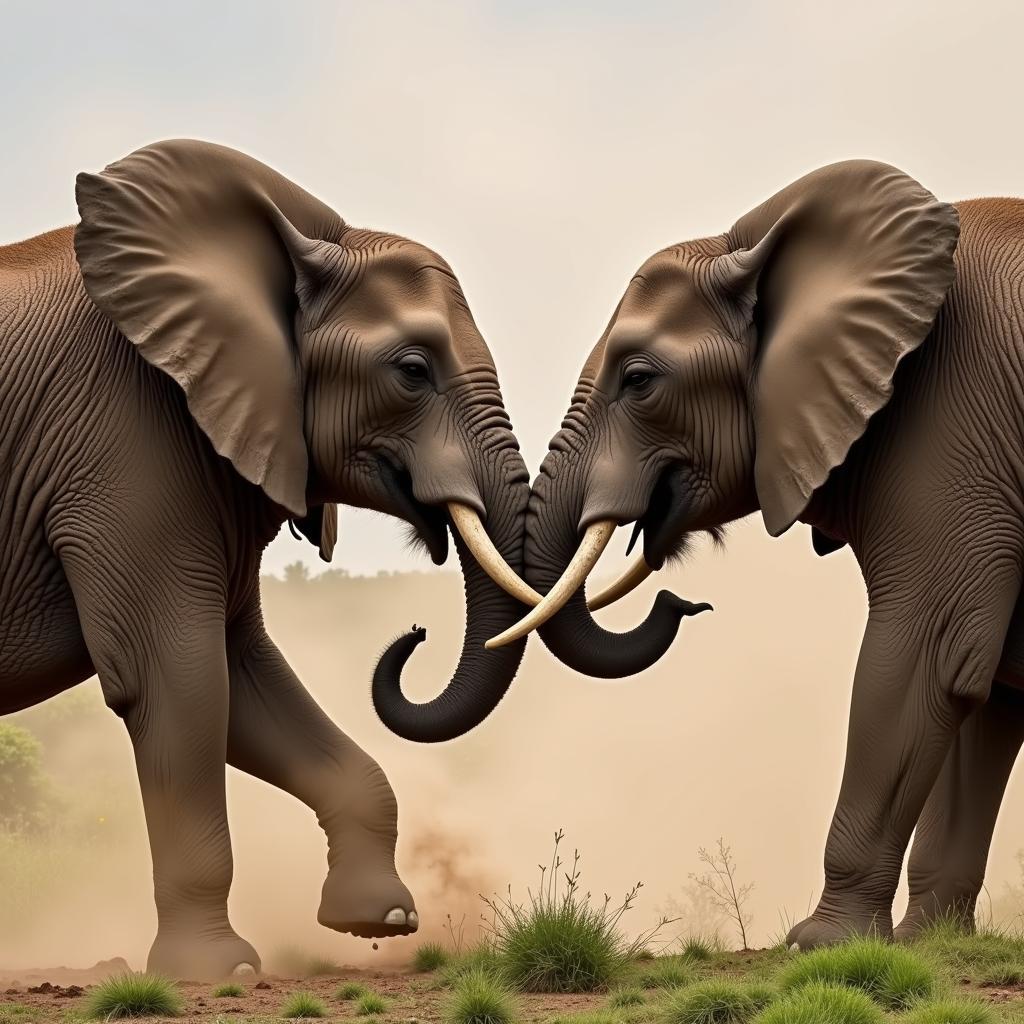African Elephant Fights: The Rumble in the Savannah
African Elephant Fights are a breathtaking spectacle of power and aggression. These majestic creatures, the largest land mammals on Earth, engage in fierce battles for dominance, territory, and mating rights. Witnessing such a display of raw strength is an unforgettable experience that leaves a lasting impression on anyone fortunate enough to witness it.
Deciphering the Language of Aggression: Why Do African Elephants Fight?
While seemingly chaotic, African elephant fights are rarely random acts of violence. They are often the culmination of complex social interactions and driven by a variety of factors, often stemming from their intricate social structures and survival instincts:
- Establishing Dominance: Within elephant herds, a hierarchy exists among males. Fights are a way for bulls to establish their position within this ranking system. The winner often gains access to resources and mating opportunities.
- Competition for Resources: Especially during periods of drought or food scarcity, elephants may fight over access to vital resources such as water holes and feeding grounds.
- Protecting the Family Unit: Female elephants, leading their young, may engage in aggressive displays to protect their calves from potential threats, including rival elephants or predators.
- Musth: Adult male elephants experience a periodic hormonal surge known as “musth.” During this time, their testosterone levels skyrocket, leading to heightened aggression and a greater likelihood of engaging in fights.
 Two bull elephants clashing tusks in a show of dominance
Two bull elephants clashing tusks in a show of dominance
The Anatomy of an Elephant Fight: A Symphony of Strength and Strategy
African elephant fights are not merely chaotic brawls; they involve a surprising degree of strategy and a fascinating display of adaptations evolved over millennia:
- Sizing Up the Competition: Before a fight breaks out, elephants engage in elaborate rituals to assess their opponent’s strength and size. They may spread their ears wide, shake their heads, and trumpet loudly to intimidate their rivals.
- Tusks: The Ultimate Weapon: An elephant’s tusks, essentially elongated incisor teeth, are formidable weapons in a fight. Bulls use their tusks to gore, lift, and toss their opponents, inflicting serious injuries.
- Head-to-Head Combat: The most iconic image of an elephant fight is two bulls pushing head-to-head, their massive bodies colliding with a bone-jarring impact. This display of raw strength is a test of sheer power and endurance.
- Trunk Warfare: An elephant’s trunk is not just a versatile tool for feeding and communication; it can also be used as a weapon. Elephants may use their trunks to deliver powerful blows, grapple with their opponent, or throw dirt and debris.
The Aftermath: Winners, Losers, and the Long-Term Impact
The outcome of an African elephant fight can have significant consequences for the individuals involved and the dynamics of the herd:
- Respect for the Victor: The victorious elephant asserts his dominance, often leading to increased access to mates and resources.
- Learning from Defeat: The defeated elephant may retreat, nursing his wounds and learning valuable lessons from the encounter. These experiences can shape future behavior and fighting strategies.
- Impact on Herd Structure: Fights between dominant males can lead to shifts in herd leadership and influence the social dynamics within the group.
Conserving Giants: Protecting African Elephants for Future Generations
Witnessing the raw power of an African elephant fight is a stark reminder of the need to protect these magnificent creatures and their fragile habitat. Poaching, habitat loss, and human-wildlife conflict continue to threaten African elephant populations across the continent.
By supporting organizations dedicated to elephant conservation, advocating for responsible tourism practices, and raising awareness about the plight of these gentle giants, we can help ensure that future generations have the opportunity to marvel at the awe-inspiring spectacle of African elephant fights in the wild.
FAQs: Unraveling the Mysteries of African Elephant Fights
Q: Are African elephant fights always fatal?
A: While fights can be intense and injuries are common, fatalities are relatively rare. Elephants typically try to avoid inflicting fatal blows on their own kind.
Q: How long do African elephant fights last?
A: The duration of a fight can vary widely depending on the age and size of the elephants involved, as well as the intensity of the rivalry. Some fights may last only a few minutes, while others can drag on for an hour or more.
Q: Do female African elephants fight?
A: While less common than fights between males, female African elephants can and do engage in aggressive displays, especially when protecting their young or competing for resources.
Exploring the Wonders of African Wildlife
Continue your journey into the heart of Africa by delving into these captivating topics:
- African children study suggesting worse outcomes with excessive fluids: Learn about groundbreaking research on healthcare practices in Africa.
- African cought site: Discover more about African wildlife and conservation efforts.
Let’s work together to ensure that the breathtaking spectacle of African elephant fights continues to grace the savannas for generations to come.
Need help planning your African adventure? Contact us at +255768904061, email us at kaka.mag@gmail.com, or visit us in Mbarali DC Mawindi, Kangaga, Tanzania. Our team is available 24/7 to assist you.


